Bren Ahearn: Artists that inspire
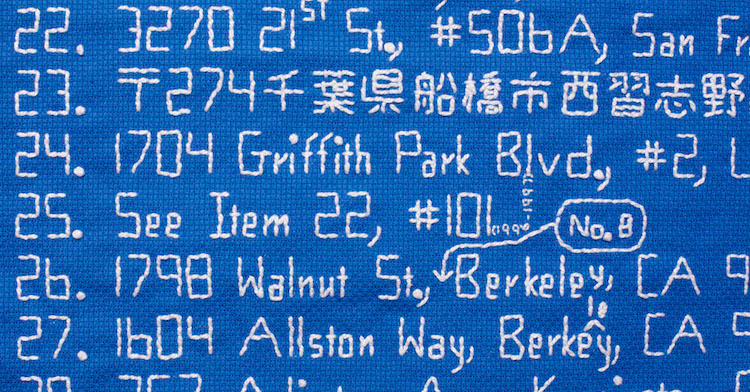
San Francisco-based artist Bren Ahearn’s embroidery draws from a variety of cultural references. His work appropriates recognisable symbols to question expectations about manhood and its assumed qualities of courage, vigour, and determination.
Bren’s samplers are imbued with feelings of tenderness, innocence, and tongue-in-cheek wit. He uses textile crafts to explore masculinity’s conflicting messages and employs the cross stitch ABC sampler form to document how he’s been educated to be a man in US society.
In this article, Bren discusses the people who have inspired him in his own creative process.
Read TextileArtist.org’s interview with Bren here
Bren Ahearn: Thank you for this opportunity to chat about a few artists who have inspired me. I have been thinking about who made the shortlist, and I realise that a primary factor has been my being exposed to these artists’ work when I was ready to receive the information. Had the stars not aligned, I might’ve taken a different path.
I’m writing this intro after I wrote the main text below, and I can see that I’ve been inspired by artists who are getting their stories out there, even if there are messages from society, implicit or explicit, that they should not tell their stories.
Crafters Anonymous, Famous and Infamous.
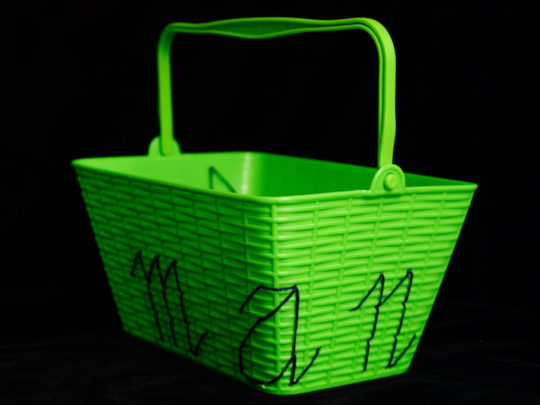
Bren Ahearn, Manmade #4, 2007, 9.5″H X 10.5″W, Double Running Stitch, Plastic Basket and Cotton, Photo by Kiny McCarrick
I’ve mentioned in previous interviews how much I’ve been influenced by my mother’s encouragement of all of her children to participate in crafty activities. I realise that my participation in the craft world is based upon millennia of craftspeople passing down their craft to future generations, and that I am not acting in a vacuum.
The internet has provided crafters the opportunity to connect and get inspired by others. Blogs like this one and Jamie Chalmers’ Mr. X Stitch, as well as social media, e.g., the Critical Craft Forum on Facebook, founded by Namita Gupta Wiggers and Elizabeth Agro, have given us a voice, visibility, and a place to discuss craft.
The readers who are familiar with my work know that my work is rooted in the home crafts tradition. Given this focus, I also am attracted to artists working in a crafty/folk arts tradition.
Two artists in this vein who immediately come to mind are Stewart Easton of London, England and Annie Aube of Portland, Oregon, USA. I am attracted to their work because in addition to their aesthetic, their work has an undertone of death and destruction, as does my work. I’m inspired by their ability to talk about death with humor. Stewart and Annie also are among the craft crossover artists, Stewart has displayed internationally and has done international residencies, and Annie has collaborated with the Japanese fashion house, Ne-Net. They both are on Instagram: Stewart and Annie.
Additionally, Amy Meissner has been collecting linens from the relatives of makers anonymous and non-anonymous through her Inheritance Project and will have exhibitions of these textiles to honor these makers and their work. So, in addition to having her own practice, Amy is doing service to the greater community and inspires me to think about what contributions I can make to the greater community.
When I started art school, I internalised the second-class status of craft; however, my realisation that I am part of a tradition of crafters and of a larger community has allowed me to bloom and to start reaching my potential. So, thanks to all crafters out there!
Frank Bonanno
Mr. Bonanno was my high school music teacher. He pushed my musicality to another level, and due to an unfortunate incident at a concert, inspired me to double-check that I had my sheet music before every performance.
One day during high school, I think he was trying to tell me it was OK to be gay, but I was not open enough to receive the information. He unfortunately passed away in 1989, due to complications from AIDS. I wish he still were around so I could tell him the impact he had on me.
I didn’t make visual art in the 1980s, and I think only now I’m beginning to address my coming of age during the time when AIDS appeared.
Back in 2008 I had a visiting teacher who assigned memorial projects. I made a memorial about coming of age when AIDS was first coming to be and not knowing how to navigate life and love. When I presented the project to the class, I started crying.
Later, that teacher gave me advice and said she was saying it “as a big sister,” which was an immediate red flag. She said that I don’t want to be known as a “gay artist.” Rather, I should be known just as an “artist.” It’s interesting how uncomfortable some people are with sexualities that aren’t cisgendered and heterosexual, and in some cases, white. I thought to myself, “This is good. Do more of that kind of work that made her uncomfortable.”

AIDS Quilt panel with Frank Bonanno’s tribute
On a related note about gender, sexuality, craft and binaries, artist and theorist LJ Roberts has written about queering craft and using craft to break out of binaries and to create new paradigms free from the constraints of “either/or.”LJ’s work also employs this theme.
Below are two images of my favorite piece of LJ’s called & CRAFTS, 2005. In 2005, the California College of Arts and Crafts changed its name to California College of the Arts. On the building at the San Francisco campus, the university had removed “and Crafts” from the signage and had not yet inserted “the” before “Arts.” LJ crafted the letters “& CRAFTS” out of lucite covered with knitting, and did a guerrilla installation of the letters, thus restoring the old name of the school.
I like how LJ used actual crafts to comment on the removal of crafts from the school’s name. The irony is that there has been a crafts renaissance since then.
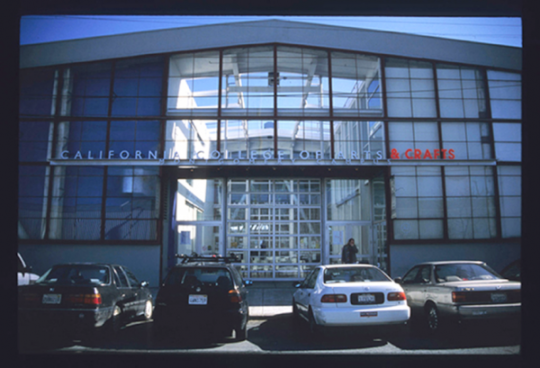
Roberts and Crafts. Photo Courtesy LJ Roberts
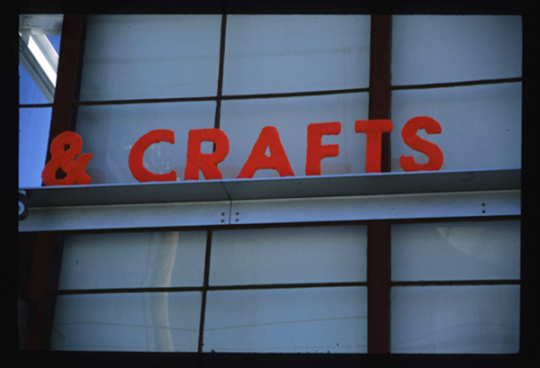
Roberts and Crafts (detail). Photo courtesy LJ Roberts
To bring these experiences up to the current moment, some of my work deals with my sexuality, and some of it deals with questioning the gender binary. Even though my work questions the gender binary, and one might say this questioning can lead to new paradigms, I wouldn’t call myself queer, since I’m cismasculine and married to a cismasculine guy. I’m just on the gay side of the straight/gay binary.
To bring us back to Mr. Bonanno, it’s too bad that Mr. Bonanno is not alive to see all of the changes that have occurred in my lifetime. Little did he know that he was planting the seed for me to be comfortable in my own skin, which eventually led me to use my work as a springboard for folks to talk about gender expectations and their own experiences.
Vic De La Rosa
Vic was my advisor when I was a student at San Francisco State University in San Francisco, CA, USA. I saw that he interjected his own experience in his work, and he encouraged me to do so.
His work deals with population migrations and his experience as a hyphenated American. His work deals with topics that some folks don’t want to discuss, and I know of at least twice when his work has been censored, most recently his work focusing on everyday people in San Francisco’s Mission District. The transit agency sponsoring the project censored one of the pieces and delayed installation. In response, Vic and his crew ended up doing a guerrilla installation of the work.
Here is a photo of Vic in front of the guerrilla installation of Mickey, the censored piece:
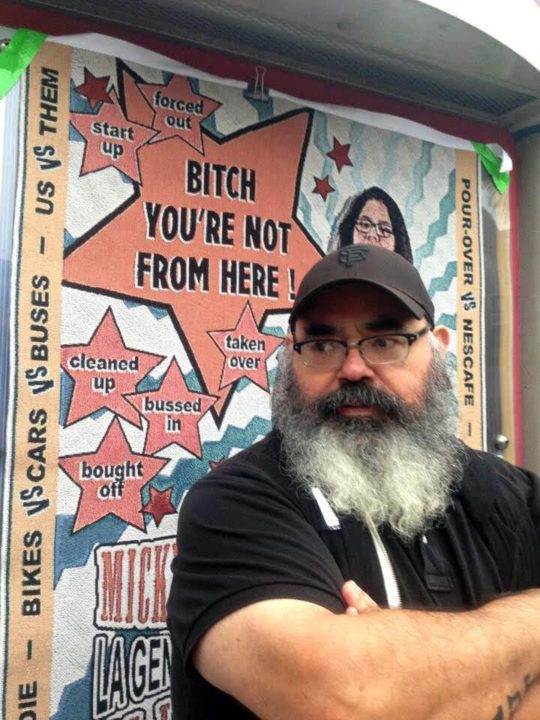
De La Rosa, Mickey. Photo by Nash Bellows
Here is his study for the 2050 US Flag:
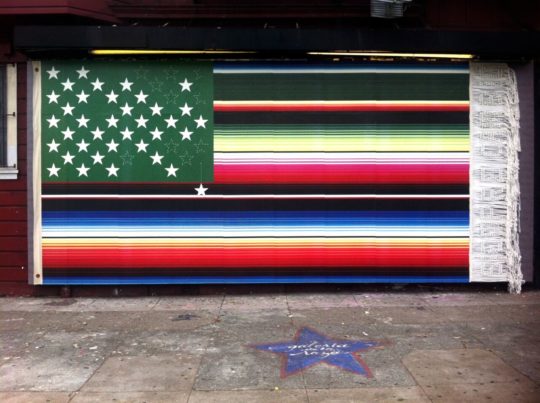
De La Rosa, Study for the 2050 U.S. Flag. Photo courtesy Vic De La Rosa
Vic inspires me to continue putting out my message and to think of creative ways of getting my work out there. He also inspires me to interject my own experience in my work.
For more information visit: www.vicdelarosa.tumblr.com
Sonya Clark
I first saw Sonya Clark’s Afro Abe ii (2010) when I was in school, and I thought, That is brilliant! The concept is simple, but the ideas expressed are so layered.
What I like about Clark is that she presents a piece and lets the viewer come to the viewer’s own conclusions. For me, this work raises several intersecting issues, among them, being racism, slavery, hair and economics.
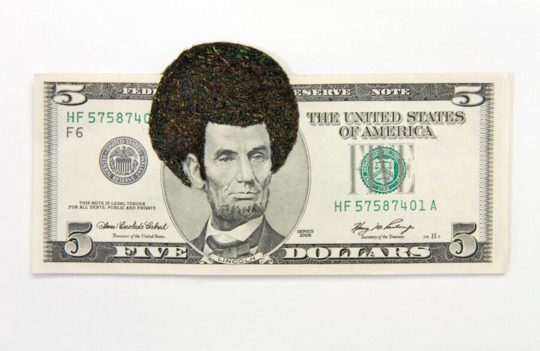
Sonya Clark, Afro Abe ii, 2010
Additionally, Clark has bodies of work surrounding hair and combs, and she uses actual hair in some pieces. These works can be seen on her site.
More recently Clark started the unraveling of a confederate battle flag on the 150th anniversary of Lee’s surrender to Grant, which ended the US Civil War. The vestiges of slavery live on, and Clark’s unraveling of this flag, and the tediousness of this labor remind the audience how complicated, time-consuming and unfinished the unraveling of slavery is.
For readers outside of the USA who aren’t familiar with the confederate battle flag, this flag was the symbol of the pro-slavery side during the American civil war.
This piece is especially relevant, given the adoption of the confederate flag by some of US President Trump’s supporters. Some people aren’t aware of and/or discount the symbolism of this flag and aren’t aware of or refuse to see linkages from slavery to current mass incarceration and lack of equal access to opportunities.
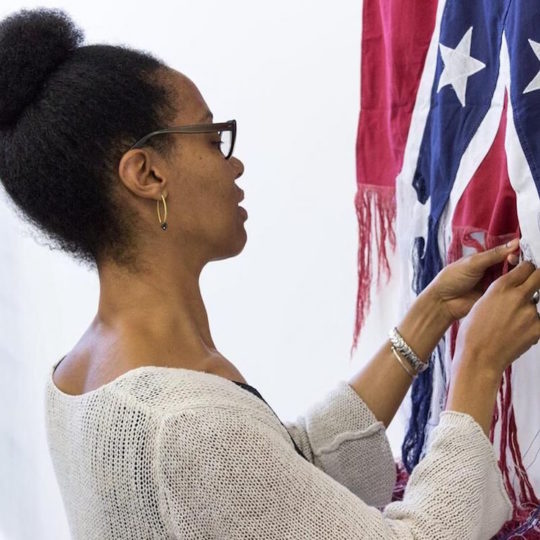
Sonya Clark unraveling confederate battle flag
In her Black Hair Flag piece from 2010, Clark incorporated hair imagery into the confederate flag, creating a perfect marriage of two of her themes:
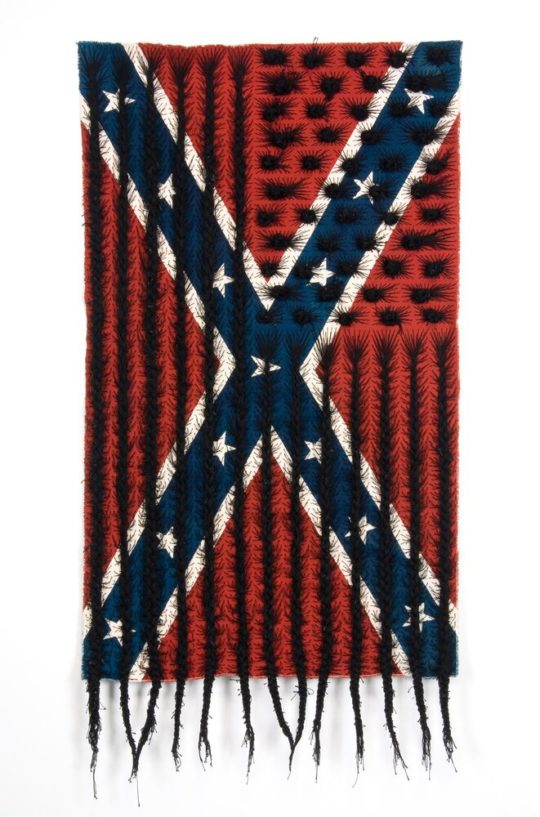
Sonya Clark, Black Hair Flag, 2010
Clark has inspired me to be mindful of symbols and the power that they possess, and to present work in a way that opens up dialogue.
For more information visit: www.sonyaclark.com
Aram Han Sifuentes
I was first exposed to Aram’s work about a year ago, and I have been enthralled ever since. Her work is on the avant-garde of craftivism, and she has that perfect integration of form, medium and message.
For example, in her ‘A Community of Non-Citizens: Proving Worth of Citizenship Through Stitching Samplers’, Aram has stitched the answers to the US naturalization test onto a sampler and has invited other non-US citizens to make samplers based on the test answers. Each sampler is being sold for $725 US, which is the cost to apply for naturalization.
She has chosen the sampler form, which is associated with education and showing worth to suitors, and used the medium of textiles, with its humble origins and erased history, to relay the message of people who are voiceless. Aram’s own experience as an immigrant adds power to this piece, i.e., she’s telling her own experience.
Here are some example samplers:
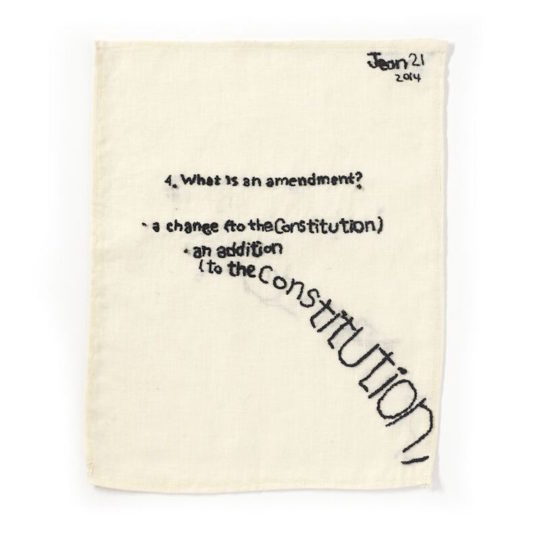
Aran Han, Question #4 by Juwon who moved from South Korea to the US in 2010
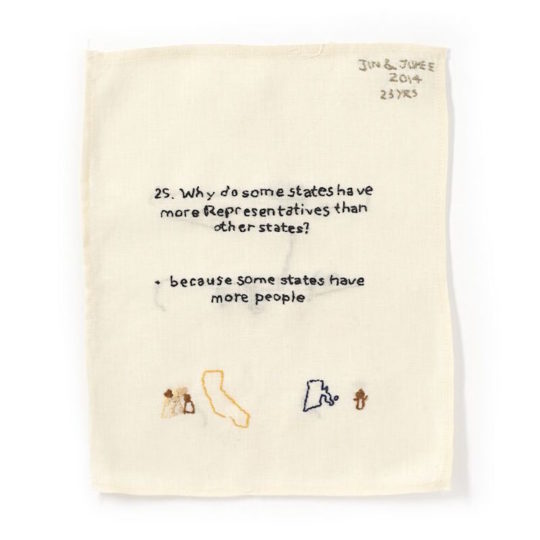
Aran Han, Question #25 by Jin and Juhee, who moved from South Korea to the US in 1999
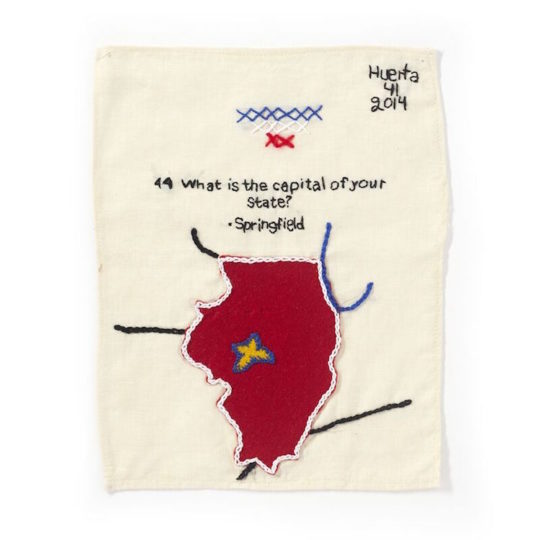
Aran Han, Question #44 by Huerta, who moved from Mexico to the US in 2004
Last year Aram collaborated on the Official Unofficial Voting Station, a place at which the 106 million people in the US and its territories who cannot vote legally could cast a symbolic ballot.
Recent work also includes the Protest Banner Lending Library. More info is on Aram’s site, and the images are from her site.
Aram has inspired me to take more direct action in creating the world I want to live in, even if I’m afraid to do so. A million frightened people coming together with the intent to enact positive change can be very powerful.
For more information visit: www.aramhan.com
@studiosinan
I have been wanting to get back into pattern repeat, and this Instagram feed by AK Mushtaq is inspiring. A lot of the images have Islamic architecture and Islamic pattern references.
A lot of the images have Islamic architecture and Islamic pattern references. I hope that during this time of extreme Islamophobia in the US, this Instagram feed may encourage some people to research and celebrate the many contributions of Islam to the worlds of art, hygiene, math, science and medicine, among others.
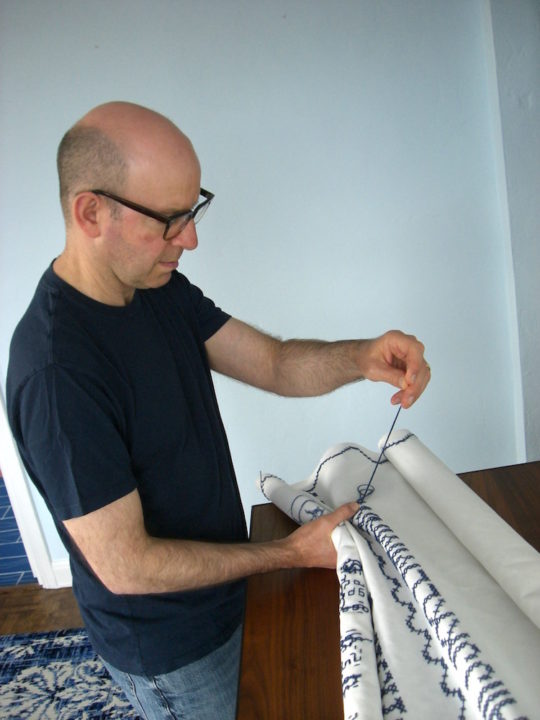
Bren Ahearn Stitching Sampler #17 in 2015
Thank you again for this opportunity to share and for all of your work for the textile community.
For more information visit: www.brenahearn.com
Tell us which artists you find inspirational by using the button below.















